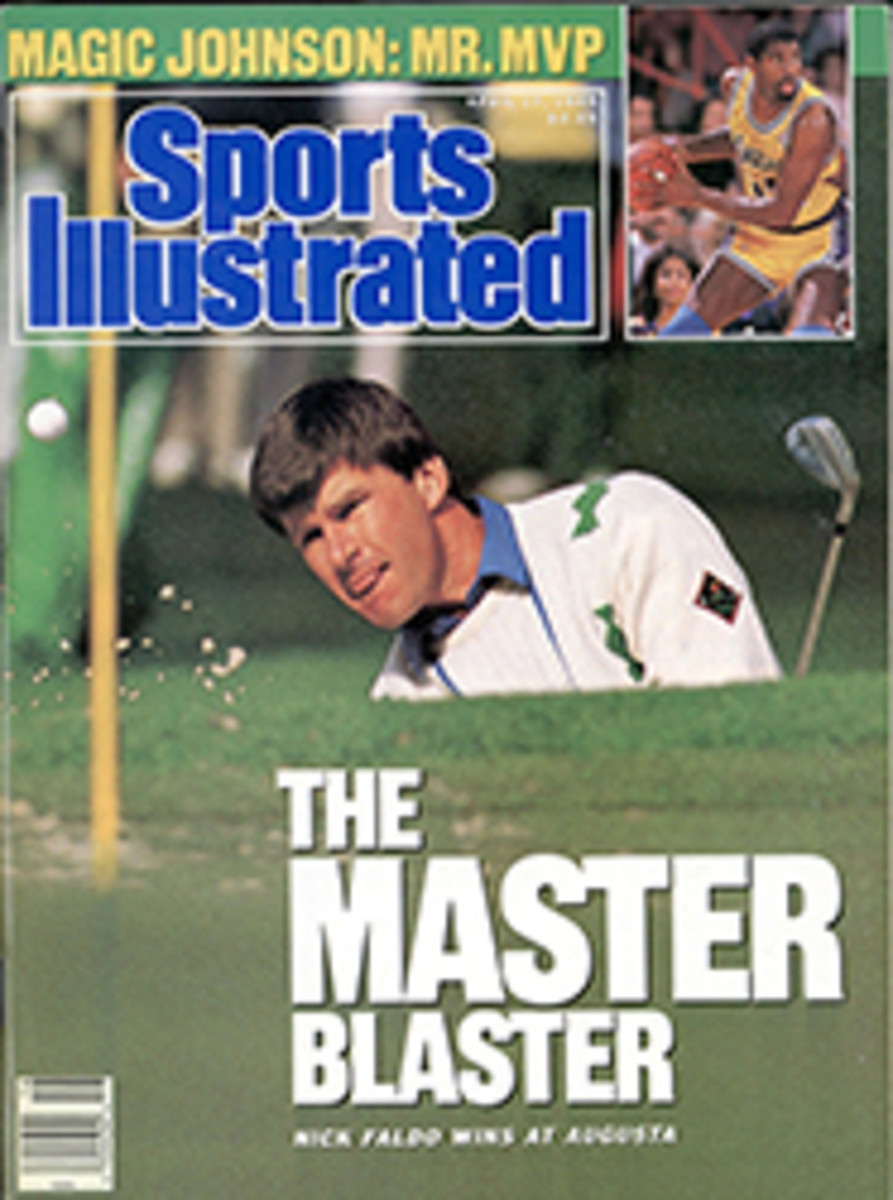
It's a REAL KICK
Make no mistake, something important was happening on the elegantly groomed soccer field of UC Irvine. The 18 young men in new red, white and blue U.S. soccer team uniforms should have been jostling and clowning as they lined up for a group photograph. Instead they looked self-conscious, anxious to please. Chins went up; expressions became solemn, as if at any moment the players were expecting a heavenly choir to break into The Star-Spangled Banner.
The spell was broken momentarily when the trainer whispered to the group, "Make sure those Adidas trefoils show up, guys!" But then the players became stiff again, tense with the knowledge that in the summer of 1990, they might hear that anthem played in one of the great soccer stadiums of Italy, when the first round of the World Cup finals gets underway.
To be sure, none of the young men—the average age is 24—is crazy enough to predict that the U.S. will actually make it all the way to the championship game in Rome on July 8, 1990. For now, just getting to be one of the 24 national teams (of the 113 that started down the qualifying trail in March 1988) that will compete in Italy would be glory enough for the Americans.
This new U.S. team is an experiment. In other countries the national side is usually made up of all-stars from the top pro clubs. But the only significant pro outfit in the U.S. is the Major Indoor Soccer League. So, to offset the lack of competition, the U.S. Soccer Federation decided last year to create an instant World Cup team using sponsorship money from corporations such as Anheuser-Busch, Adidas and Chiquita Brands. The funds have been flowing freely since last July, when the Fèdèration Internationale de Football Association (FIFA), the sport's governing body, decided to hold the 1994 World Cup in the U.S. The 15-man nucleus of the 1990 American team, made up primarily of '88 Olympians, will train and play together through the third and final qualifying round, which begins for the U.S. in Costa Rica on April 16, and, with luck, the team will go on to Italy next year.
Most of the U.S. players clearly are not in it for the money. The average grant for these 15 players is only $25,000 a year, and the USSF's sponsorship agreement with Adidas means that the endorsement deals a few players have with Puma are likely to be scuttled. That is ironic, because the U.S. team's total income is significantly less than the reputed $1 million that Diego Maradona, Argentina's superstar, earns each season for pulling on his Pumas.
But the loss of such endorsements is a small sacrifice compared with the kind of money some players are giving up by not playing in the MISL. Midfielder John Stollmeyer, who was the MISL Rookie of the Year in 1986-87 with the now defunct Cleveland Force, was offered more than twice his U.S. team salary to play for the San Diego Sockers. He turned down the offer because it wouldn't have given him enough time to practice the outdoor game.
He might have been less resolute if this were not the first time since 1950 that the U.S. has a good chance to make it beyond the qualifying rounds. Indeed, it seems as if there's almost a conspiracy at work to assure the U.S. a berth in the World Cup finals. Last summer, for instance, FIFA hit Mexico with a two-year suspension from international competition for using overage players in an under-20 world championship qualifier the previous April. Mexico is traditionally the top dog in CONCACAF, the confederation of North American, Central American and Caribbean countries that makes up the U.S.'s qualifying group. Next, lightly regarded Guatemala, in a major upset, eliminated Canada in second-round play, and Trinidad and Tobago disposed of another perennial power, Honduras. Meanwhile, the U.S. was given a bye in the first round and beat Jamaica in the second. Now all the U.S. must do to make it to Italy next year is to finish first or second in the final qualifying round, a home-and-home round-robin with Costa Rica, Guatemala, Trinidad and Tobago, and El Salvador. Piece of cake, sí?
It should be. At least that's how U.S. captain Ricky Davis, a former midfielder with the New York Cosmos who, at 30, is widely considered the first U.S. world-class player, sees it. "Look at these new kids," Davis said at Irvine, pointing to his teammates. "We've got Tab Ramos, who started on a junior national side when he was 15 and later played in the Pan Am Games and in the Olympics. And John Harkes—he's only 21, and he played in Seoul. These kids are a hundred times better prepared for the international level than I was at their age."
Perhaps the most positive legacy of the North American Soccer League is the massive infrastructure of youth soccer that was built in the U.S. during the NASL years, 1967-84. The first generation of players to come out of that movement is now beginning to have an impact on the international scene. In 1985 and '87, both the under-20 and under-16 national teams fought their way to qualify for the FIFA world championship in their age groups, and last year the U.S. was one of 16 teams that made it into the Olympics. In January, when nobody seemed to be looking, a U.S. team took the bronze in the first FIFA five-a-side world indoor championship in Rotterdam. In an even bigger triumph, the U.S. made it to the final four in last month's under-20 world championship in Saudi Arabia, beating the powerful East German team 2-0 along the way. It was the first time since 1930 that a U.S. team had gotten beyond the first round in world outdoor competition. That bodes well for the future, because many of the current under-20 players will be the core of the 1992 Olympic and 1994 World Cup teams.
Even before the results from Saudi Arabia were in, the feeling in Irvine was that a new era was dawning. Just back from the Netherlands was Eric Eichmann, 23, who scored a goal for the U.S. in the 5-3 victory over Brazil—yes, Brazil!—in the world five-a-side championships. "You know," he said, "In Holland we discovered we could win."
At the same time, the USSF is also showing signs of shedding its chronic amateurism. With the building of the new team, the federation said farewell to its talented but part-time coach, Lothar Osiander. During his three-year tenure with the U.S. team, Osiander was at times unable to show up for practice or exhibition games because of other commitments. Now he has returned to his other—more lucrative—line of work, as the headwaiter at Graziano's, a restaurant in San Francisco.
For a while, rumor had it that the USSF was trying to steal the legendary Franz Beckenbauer away from West Germany to coach the U.S. team. But in the end, the federation decided to hire Bob Gansler, 47, who was born in Hungary but learned the game in the United States. Gansler's soccer career is a classic American one. He coached at Marquette University, as a graduate student; he was the captain of the U.S. Olympic teams in '64 and '68; he did a one-season stint as a defender with the NASL's Chicago Mustangs in 1968; he played on and coached a club team called the Milwaukee Bavarians for 14 years; and he was the head coach at the University of Wisconsin-Milwaukee from 1984 to '88. In addition, he was the coach of the under-20 national team until January.
All this home cooking is fine by Davis. "A coach needs to understand American players," he says. "That was the downfall of the other two [Osiander is a West German; his predecessor, Alkis Panagoulias, is a Greek]. They couldn't understand our mentality, the way Americans are educated to ask if they don't understand something."
Nevertheless, there are those who question the choice of Gansler because of his lack of top-level international experience. Soccer is an intuitive game, susceptible to being overcoached, and Gansler's critics argue that because he has coached primarily in U.S. colleges, he is too married to the structured American style of play, which, unlike the international game, allows unlimited substitutions.
In response, Gansler says, "I play with what I have. I'm a realist. The more players I have who lack the top kind of intuition, the more structured I have to play."
He uses forward Hugo Perez, a former midfielder for the Sockers and perhaps the most talented player on the U.S. team, as an example. "It would be crazy for me to put a tactical straitjacket on Perez," says Gansler, "but I have to be sure the players around him know how to respond to what he does."
Gansler's biggest problem, as he sees it, is trying to keep his team together through 1990. Besides the ever-present lure of the MISL, he has to be wary of a trend that is just beginning—the trickle of some of the best U.S. Olympians to professional teams in Europe. Midfielder Bruce Murray now plays in Switzerland, forward Frank Klopas in Greece, forward Peter Vermes in Hungary, and defender Paul Caligiuri in West Germany. All of them except Caligiuri, however, have been released by their teams to play in the U.S.'s first third-round match on Sunday. The U.S. team's top scoring threat, Brent Goulet of Tacoma, Wash., was offered a four-week trial by Borussia Dortmund of the Bundesliga, a leading pro league in West Germany, but he turned it down. "They would've had to make it right with the USSF," he says. "I would still want to play for the U.S. in the big games. But, hey, the Bundesliga!"
Another problem for Gansler is finding world-class teams to practice against this year. In March the U.S. team traveled to Paraguay and beat two clubs, Sporting Colombia and Cerro Porteno, and last weekend it finished second in the Marlboro Cup in Miami, losing in a shootout to Colombia's Independiente Santa Fe team in the final. Still, that sort of competition is not the same as playing in the European pro leagues every week.
Gansler is fairly confident the team will have an appointment in Italy next year. "It's realistic to say we'll qualify," he says. "But you should never belittle the Latins at home. And I saw the Trinidadians—big and leggy, with strength and speed, English style—take out the Hondurans in Central America in front of 35,000 crazy fans. I wouldn't want to underrate those guys."
Davis is less cautious. "We'll have the best preparation of any of the countries left in CONCACAF," he says. "We'll make it to Italy for sure. And I'll get a few goals."
PHOTO
PETER READ MILLER
On Media Day the U.S. unveiled its new team, which should be smiling all the way to Italy.
PHOTO
PETER READ MILLER
Perez may be the most talented American, but Gansler won't let him be all intuitive.
PHOTO
PETER READ MILLER
Like many of his teammates, defender Mike Windischmann honed his skills in Seoul.
PHOTO
PETER READ MILLER
Gansler (left) won't have to worry about serving diners on the side, as Osiander did.
PHOTO
GEORGE STEINMETZ
[See caption above.]

